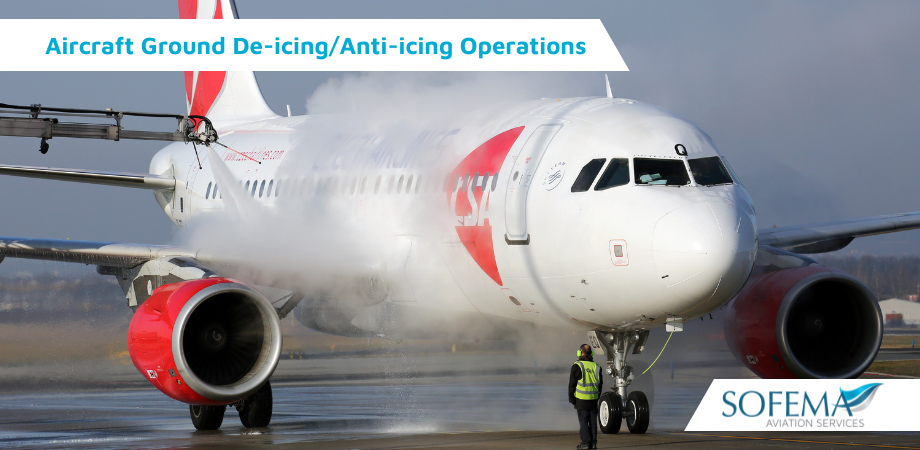Comments regarding Aircraft Ground De-icing by Sofema Aviation Services (SAS) www.sassofia.com
Introduction
The successful treatment of ice and snow deposits on aeroplanes on the ground is an absolute necessity to the safety of winter operations.
Requirements and guidance can be found in the following ICAO documents:
Annex 6 — Operation of Aircraft
· Part I — International Commercial Air Transport — Aeroplanes
o References to ground de-icing/anti-icing are in Part I, 4.3.5.4 with a requirement for de-icing/anti-icing treatment and inspection prior to take-off in suspected or known ground icing conditions:
o 4.3.5.4 A flight to be planned or expected to operate in suspected or known ground icing conditions shall not take off unless the aeroplane has been inspected for icing and, if necessary, has been given appropriate de-icing/anti-icing treatment.
o Accumulation of ice or other contaminants shall be removed so that the aeroplane is kept in an airworthy condition prior to take-off.
Note – Guidance material is given in the Manual of Aircraft Ground De-icing/Anti-icing Operations (Doc 9640).
· Part I, Appendix 2, 5.6 requires instructions for the conduct and control of ground de-icing/anti-icing operations to be included in an operator’s Operations Manual.
· The Preparation of an Operations Manual (Doc 9376) Second Edition 1997, 8.7.3 also provides guidance on the content of an operations manual with respect to de-icing/anti-icing operations.
Annex 14 — Aerodromes, Volume I
· Aerodrome Design and Operations and the Aerodrome Design Manual, Part 2.
· Taxiways, Aprons, and Holding Bays (Doc 9157) also contain references to ground de-icing/anti-icing requirements.
The Manual of Aircraft Ground De-icing/Anti-icing Operations (Doc 9640) provides a general description of the various factors relating to aeroplane icing on the ground.
It addresses the minimum procedural requirements necessary to conduct safe and efficient operations during those conditions which require aeroplane de-icing and anti-icing activities.
The “clean aircraft concept” is described.
Doc 9640 refers to Types I, II, III, and IV fluids and also to methods for de-icing which do not use fluids.
Examples of application and holdover timetables are provided for Types I, II, and IV fluids.
Doc 9640 also contains material on equipment, quality assurance programmes, and the annual updating of holdover time guidelines and de-icing/anti-icing procedures.
The primary purpose of the publication of this manual was to encourage international standardization of de-icing/anti-icing activities.
Note – ICAO does not have requirements concerning the licensing of personnel for the conduct of de-icing/anti-icing operations.
Annual Updating of Information on Qualified Fluids, Holdover Time Guidelines, and Procedures
Holdover times and procedures are continually updated by an international group of experts under the auspices of the Society of Automobile Engineers (SAE) G-12 Committee on Aircraft Ground De-icing/Anti-icing through its Holdover Testing Committee.
· This group of experts is composed of representatives of the world’s airlines, anti-icing fluid manufacturers, aviation regulatory authorities, and research organizations.
· De-icing/anti-icing fluids are qualified to the appropriate specification by certified laboratories.
· Qualified fluids are tested jointly by the United States Federal Aviation Administration (FAA) and Transport Canada to establish the fluid endurance time data, from which the holdover time guidelines are generated by the Holdover Testing Committee.
· The de-icing/anti-icing procedures are developed by the Methods Subcommittee.
· The holdover time guidelines and procedures are approved by the SAE Aerospace Council.
EASA Regs De-icing
AMC2 ORO.MLR.100 Operations manual – General (ED Decision 2017/007/R)
Contents of the Operations Manual for Certain Types of Operation
· 8.2.4 De-icing and anti-icing on the ground.
o A description of the de-icing and anti-icing policy and procedures for aircraft on the ground.
o These should include descriptions of the types and effects of icing and other contaminants on aircraft whilst stationary, during ground movements and during take-off.
o In addition, a description of the fluid types used should be given, including the following:
· (a) proprietary or commercial names,
· (b) characteristics,
· (c) effects on aircraft performance,
· (d) hold-over times,
· (e) precautions during usage.
AMC1 ORO.FC.230 Recurrent training and checking – ED Decision 2016/019/R
Recurrent Training Syllabus
· Recurrent training – should comprise the following:
o Ground training – The ground training programme should include:
· (A) aircraft systems;
· (B) operational procedures and requirements, including ground de-icing/anti-icing and pilot incapacitation; and
· (C) accident/incident and occurrence review.
Knowledge of the ground training should be verified by a questionnaire or other suitable methods.
When the ground training is conducted within 3 calendar months prior to the expiry of the 12 calendar months period, the next ground and refresher training should be completed within 12 calendar months of the original expiry date of the previous training.
CAT.OP.MPA.250 Ice and Other Contaminants — Ground Procedures (Regulation (EU) No 965/2012)
(a) The operator shall establish procedures to be followed when ground de-icing and anti-icing and related inspections of the aircraft are necessary to allow the safe operation of the aircraft.
(b) The commander shall only commence take-off if the aircraft is clear of any deposit that might adversely affect the performance or controllability of the aircraft, except as permitted under (a) and in accordance with the AFM.
Next Steps
Follow this link to our Library to find & Download related documents for Free.
Sofema Aviation Services (SAS) and Sofema Online (SOL) provide EASA Regulatory Compliant and Vocational training delivered as classroom, webinar, and online certificated courses – for details please see the websites www.sassofia.com & www.sofemaonline.com or email team@sassofia.com
Tags:
Aircraft, Aircraft Anti-icing, Aircraft De-icing, Aircraft Ground De-icing, Anti Icing Fluids, aviation, Aviation Flight Operations, Rear mounted Engine, SAS blogs




